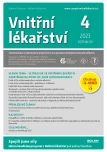Osteomalacia
Authors:
Jan Rosa
Authors‘ workplace:
Osteocentrum Affidea Praha, Lékařská fakulta Univerzity Karlovy v Hradci Králové
Published in:
Vnitř Lék 2023; 69(4): 254-260
Category:
Review Articles
doi:
https://doi.org/10.36290/vnl.2023.048
Overview
Osteomalacia with characteristic histomorphometric, radiographic, laboratory and clinical features is a prominent syndrome of disturbed bone mineralisation in adulthood.
From an etiological point of view, osteomalacia is usually caused by substrate (calcium, phosphate) deficiency, presence of excess mineralization inhibitors or deficiency or ineffectivness of mineralization facilitator (vitamin D).
In proportion to the high number of congenital and acquired causes of osteomalacia, its clinical and laboratory picture is heterogeneous and rarely fully expressed.
The treatment of a particular case is determined by the cause of osteomalacia and may (but does not necessarily) include correction of the underlying disease, administration of calcium and various forms of vitamin D, as well as orthopaedic interventions. For some of the hereditary forms, biological or replacement therapy is prospectively available.
The article attempts to cover the whole range of osteomalacia variants, mentioning a fact discussed only in recent years – the occurrence of oligosymptomatic, incompletely expressed forms.
Keywords:
osteomalacia – bone matrix – bone mineral – mineralization – osteoid
Sources
1. Zhou, R, Guo Q, Xiao Y, et al. Endocrine role of bone in the regulation of energy metabolism. Nature Bone Research. 2021;9:25.
2. Boivin G, Meunier PJ. The mineralization of bone tissue: a forgotten dimension in osteoporosis research. Osteoporos Int. 2003;14(Suppl 3):S19-S24.
3. Yadav MC, Simão AMS, Narisawa S, et al. Loss of skeletal mineralization by the simultaneous ablation of PHOS‑PHO1 and alkaline phosphatase function: a unified model of the mechanismsof initiation of skeletal calcification. J Bone Miner Res. 2011;26:286-297.
4. Hinson J, Raven P, Chew S. Hormonal regulation of plasma calcium and calcium metabolism. In: The Endocrine System (Second Edition). 2010;147-159.
5. Jannin A, Kerlan V, Desailloud R. Endocrinology of bone mineralization: An update. Annales d’Endocrinologie. 2022;83:46-53.
6. Bhan A, Qiu S, Rao SD. Bone histomorphometry in the evaluation of osteomalacia. Bone Rep. 2018;8:125-134.
7. Dempster DW, Compston JE, Drezner MK, et al. Standardized nomenclature, symbols, and units for bone histomorphometry: a 2012 update of the report of the ASBMR Histomorphometry Nomenclature Committee. J Bone Miner Res. 2013;28:2-17.
8. Fukumoto S, Ozono K, Michigami T, et al. Pathogenesis and diagnostic criteria for rickets and osteomalacia–proposal by an expert panel supported by the Ministry of Health, Labour and Welfare, Japan, the Japanese Society for Bone and Mineral Research, and the Japan Endocrine Society. J Bone Miner Metab. 2015;33:467-473.
9. Finch PJ, Ang L, Eastwood JB, Maxwell JB. Clinical and histological spectrum of osteomalacia among Asians in south London. Q J Med. 1992;302:439-448.
10. Priemel M, von Domarus C, Klatte TO, et al. Bone Mineralization Defects and Vitamin D Deficiency: Histomorphometric Analysis of Iliac Crest Bone Biopsies and Circulating 25-Hydroxyvitamin D in 675 Patients. J Bone Mineral Res. 2010; 25:305-312.
11. Smerdon GT. Daniel Whistler and the English Disease: A Translation and Biographical Note. J Hist Med Allied Sci. 1950;5:397-415.
12. Dunn PN. Francis Glisson (1597–1677) and the „discovery“ of rickets. Arch Dis Child Fetal Neonatal Ed. 1998;78:F154-F155.
13. Newton G. Diagnosing Rickets in Early Modern England: Statistical Evidence and Social Response. Soc History Medicine. 2021;35:566-588.
14. Wheeler BJ, Snoddy AM, Munns C, et al. A Brief History of Nutritional Rickets. Front Endocrinol. 2019;10:795.
15. Stoddard CS. Osteomalacia. California State Journal of Medicine. 1905;3:155-156.
16. Padidela R, Nilsson O, Makitie O, et al. The international X‑linked hypophosphataemia (XLH) registry (NCT03193476): rationale for and description of an international, observational study. Orphanet Journal of Rare Diseases. 2020;15:172.
17. Conti F, Ciullini L, Pugliese G. Hypophosphatasia: clinical manifestation and burden of disease in adult patients. Clin Cases Mineral Bone Metabol. 2017;14:230-234.
18. Lips P, de Jongh RT. Vitamin D deficiency in immigrants. Bone Reports. 2018;9:37-41.
19. Yousef S, Manuel D, Colman I, et al. Vitamin D Status among First‑Generation Immigrants from Different Ethnic Groups and Origins: An Observational Study Using the Canadian Health Measures Survey. Nutrients. 2021;13:2702.
20. Hordon LD, Peacock M. Osteomalacia and osteoporosis in femoral neck fracture. Bone Miner. 1990;11:247-59.
21. Kumar K, Bhayana H, Vaiphei K, et al. Coexistence of Osteomalacia in Osteoporotic Hip Fractures in More Than 50 Years Age Group. Indian Journal of Orthopaedics. 2021;55:614-620.
Další literatura u autora
a na www.casopisvnitrnilekarstvi.cz
Labels
Diabetology Endocrinology Internal medicineArticle was published in
Internal Medicine

2023 Issue 4
Most read in this issue
- Osteomalacia
- Point‑of‑Care Ultrasound in internal medicine
- In the prevention of dementia, the focus should be on early and consistent treatment of hypertension
- Deep vein thrombosis – the role of ultrasound in the diagnosis and follow-up of patients
